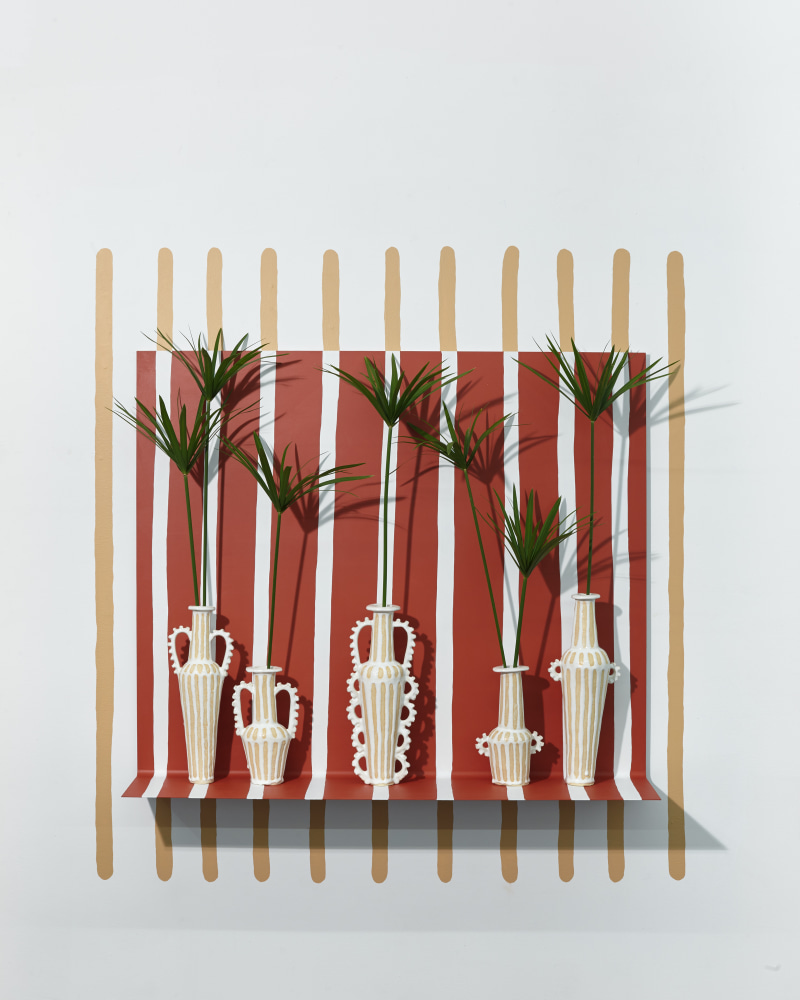
Emily Mullin Reviewed in The Brooklyn Rail
William Corwin on Mullin's Exhibition 'Woman on Top'
December 11, 2018

Emily Mullin’s project of creating a three dimensional still-life involves a complicated chain of reasoning cloaked in a seemingly simple premise. On the one hand, still lifes exist everywhere, but it is creating an assemblage in real space which inhabits two-dimensional pictorial space that lends her efforts an edge. Creating a physical space that can host the intrusion of the institution of painting adds another qualifier. The problem is the reverse of what seems intuitive—Mullin’s is not a process of taking something two dimensional, i.e. the painted still life, into the three dimensional realm. This is the slippery matter of retaining a strong flavor of flatness, gesture, and the expressivity of painted material while existing in real space. Mullin follows a recipe: a ceramic vessel is placed on a steel shelf and a still fresh cut bloom or branch is placed within. Sometimes the wall around the installation is painted as well. In Pleasure Palace (all works 2018) a tall black-and-white checkerboard patterned vase is placed on a steel shelf painted in a similar pattern, but in pale yellow-and-white. The relatively narrow shelf component with an arched top mimics a niche structure, but the checkerboard patterns—loosely painted by hand on the shelf, and imprinted in lugubrious glazing on the vessel itself—resonate back and forth, obscuring a sense of precision or actual depth. Mullin doesn’t force any kind of perspective on the view or viewer, instead she works to confuse our perception of physical space in the same way that Cézanne’s canvasses often begin to decompose as they approach the edges. The flickering between gloss and flatness as well as the indistinctness of line lend the works a hazy unreality, and they float like unframed images on the wall.
Mullin’s works adhere to a tight logical framework that calls to mind the musical constraints of an arrangement by Bach: there are a set number of variables and these are contained. Clearly there is a nod to Betty Woodman’s alternate realities: the steel shelves and wall painting position the ceramic works in real space, but Mullin’s universe is hermetically sealed; the vessel mirrors its environment and vice versa. Unlike Woodman’s gangly and seemingly unusable objects, Mullin pledges allegiance to the concept of practicality, going so far as to show her vases containing vestiges of living organisms. Whether it is a clever ruse—meant to leave the viewer questioning the use of pattern as a vehicle of adhesion within installation art—or an afterthought meant to invent a sumptuous environment for a singular object, the traditional nature of Mullin’s vessels is a quandary. Grayson Perry builds on the vase as memorial and narrative object, and then expands and elaborates from a relatively humble object into an expansive and sometimes overbearing epic. Mullins on the other hand limits herself, preventing narrative through strict pattern or surface texture. In Together Forever and Sauce On It, the two pairs of vases eschew all pattern and instead have a glistening deep oxidized bronze earthenware finish. While the steel shelf element in Sauce On It has a gentle pattern mimicking the hemispherical edging on the ceramics, thus offering a visual linkage, Together Forever challenges the viewer to believe that there is more here than simply two vessels on a shelf. Mullin is at her most convincing though when she offers viewers more to see, enveloping detailed works such as Top 5 and Bananas in which the pattern runs off the shelf or vessel; or Like So which plays with repetition and optical flickering do actually call to mind the still lifes of Matisse or Hockney—she obviously enjoys hovering between modernism and postmodernism.
What is most striking—and this again recalls the reference to Bach—is Mullin’s sense of control. The vegetation inhabiting the installations is carefully pruned, with long-living hearty blossoms, snippets of evergreens or even dried flowers: there is an active campaign to remove any sense of decay—these are not memento mori. Similarly in sensibility, the vessels, while sometimes having outlandish volumes or elaborate handles, never stray from a basic symmetry; the handles in works like Showtime and Staring Contest begin to resemble the over-the-top ruffles in 17th century Dutch portraits or the hairdos of the Infantas and ladies-in-waiting in Velazquez and Goya. If these are subversive gestures, they are also carefully choreographed so as to be only subtly discernable, but very emblematic and fitting for a medium as traditional and practical as ceramics. Mullin presents the object and its image, and leaves us wondering where one begins and the other ends.